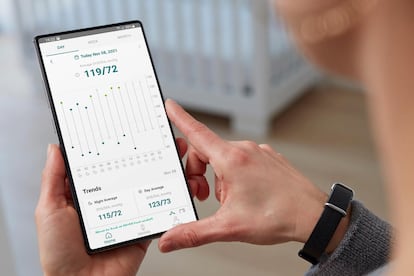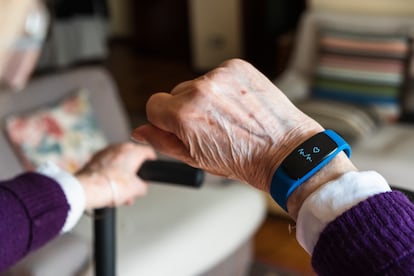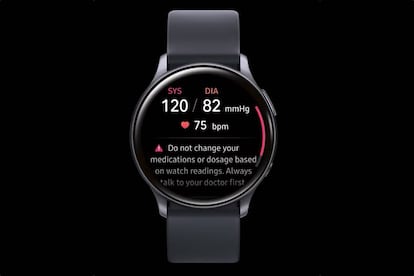Taking your blood pressure with your phone or watch: There are devices for sale, but they lack medical validity
New device sensors on the market seek to facilitate self-testing, but it is not easy to measure blood pressure 24 hours a day and non-intrusively

If just by looking at our watch or cell phone we can know, in real time, our heart rate, the number of steps we take, the calories we burn and the hours of sleep we got the night before, why can’t we also know our blood pressure?
Blood pressure is the force that the blood exerts against the arterial walls. It is defined by two values: systolic, or maximum pressure, which is the thrust of the blood pumped through the body by the contraction of the heart; and diastolic, or minimum pressure, which occurs when the heart relaxes. The American Heart Association considers blood pressure to be normal when it does not exceed pressures of 120 mmHg systolic and 80 mmHg diastolic — which we see presented as 120/80 mmHg.
When values are below 90/60 mmHg, the person is exhibiting hypotension. In athletes, this may be asymptomatic and without risk. But in other circumstances, it causes symptoms such as dizziness, nausea, pallor, blurred vision, confusion and fainting, because the brain isn’t receiving enough blood. Very low blood pressure can be life-threatening because of shock, a state where organs suffer damage due to lack of blood flow. This is more common in the elderly and can be precipitated by sudden changes in position, dehydration, infections, bleeding, certain medications and diseases such as Parkinson’s and diabetes.
Above 140/90 mmHg, the person is said to have high blood pressure. Researchers have calculated that in people ages 40 to 69, for every 20 mmHg increase in systolic blood pressure and 10 mmHg increase in diastolic blood pressure, the risk of coronary heart disease and stroke doubles. Worldwide, some 1.28 billion people between the ages of 30 and 78 have hypertension, most of them living in low- and middle-income countries, and more than half of them are not treated, according to a 2021 study published in The Lancet. This is despite the fact that hypertension can be easily detected by measuring blood pressure — at home or in a health facility — and can often be effectively treated with low-cost medications.
Today, a new generation of blood pressure devices aims to make it easier to diagnose — and control — hypertension. Unlike traditional devices, they do without the arm cuff and offer blood pressure values on demand, should the user press their finger on a sensor, or continuously, if measured by a watch, ring or bracelet.
“Regular blood pressure monitoring in all adults would improve hypertension awareness. For those who have hypertension, it may improve their control,” says Ramakrishna Mukkamala, a bioelectrical engineer at the University of Pittsburgh, who coauthored a look at blood pressure measurement using cuff-free devices in the 2022 Annual Review of Biomedical Engineering. “For example, if patients continue to see that their blood pressure is high, they may finally become compliant in taking their medications.”
Leaving the cuff behind
The measurement of blood pressure goes back almost three centuries (see sidebar), leading to the procedure that we all know and that our family doctor performs when we have checkups: A cuff goes around our arm and is inflated, then deflated, in a controlled manner, to determine our maximum and minimum blood pressure.
But the use of inflatable-cuff blood pressure monitors has some drawbacks. For one thing, unless people have home monitors — and a survey of adults ages 50 to 80 in the United States found that only 55 percent of hypertension patients surveyed owned one — they must go to a pharmacy, doctor’s office or health center to learn what their blood pressure is.
Another barrier is that repeated inflation and deflation of the cuff is disruptive and can cause difficulties when, for example, a patient is in the hospital and needs frequent blood pressure monitoring. And a third drawback is that since cuffs don’t allow continuous measurement of blood pressure, they’re only providing a measurement at a specific moment.
The new cuffless devices promise to reveal a more complete picture of physiologic changes in blood pressure that cannot be picked up with spot measurements, and instead give a truer blood pressure profile, says Alberto P. Avolio, a biomedical engineer at Macquarie University in Sydney, Australia, a coauthor of the article in the Annual Review of Biomedical Engineering.

The various cuffless measuring devices are based on methods that, instead of directly determining blood pressure, use sensors to capture various indirect signals. These signals are processed by different algorithms or sets of mathematical procedures to obtain the blood pressure values. It is like inferring fever by measuring an increase in palpitations and sweating instead of using a thermometer, or divining the result of a soccer match from outside the stadium by listening to the screams of the spectators.
One of the detection methods uses optical sensors. The technique is based on the principle of photoplethysmography or PPG: It consists of illuminating a segment of the skin and analyzing the difference between the light that is emitted by the instrument and how much is detected by a photoreceptor. This difference depends on the diameter of the artery, the blood volume and the concentration of hemoglobin (the oxygen-carrying protein) at the measurement site. During the systolic phase, when the heart pumps blood, the difference between emitted and reflected light will be at its maximum, because there will be more blood flow and thus more hemoglobin and other light-absorbing proteins; during the diastolic or relaxation phase, it will be at its minimum. The algorithm relates these measurements to blood pressure.

This is the same method used by the Apple Watch and other devices to measure heart rate, and by the pulse oximeters that became popular during the Covid-19 pandemic to record the level of saturation, or oxygenation, of the blood. It is also the method used by the Swiss company Aktiia’s wristband, available only in Europe for now. This device automatically records blood pressure values over 24 hours, even when someone is sleeping, averaging the results every two hours and displaying the results through an app on a smartphone.
There are also electrical sensors, which are modified versions of the electrocardiogram that measures the electrical activity of the heart; mechanical sensors, used in ballistocardiography and seismocardiography, which attach to the surface of the skin to capture small variations in pressure; and bioimpedance sensors, similar to the instruments that analyze body composition by measuring the body’s resistance to the flow of electrical current.
Calibrated and uncalibrated
There are two broad categories into which these new cuffless blood pressure measurement devices can be grouped: those that require calibration — periodic comparison of the recordings with those obtained with a manual or digital sphygmomanometer — and those that do not.
Both types of devices capture signals from the body noninvasively, from the fingertip, ear or wrist, to name the most common sites. The estimated blood pressure is then displayed or transmitted to nearby devices, such as smartphones or tablets.
One of the measurement methods that require calibration is the pulse transit time, or PTT, which represents the time in milliseconds that the pulse takes to travel between two arterial points: The stiffer an artery is, the higher the arterial pressure will be (because the pulse travels faster) and the lower the PTT will be. This method is the one with the most scientific evidence to date.
Another is based on analysis of the shape and amplitude of the pulse wave, which is the pressure wave depicting the propagation of the blood pumped by the heart through the entire arterial tree, and whose characteristics depend in part on the rigidity of the artery walls. In people with hypertension, the amplitude of the pulse wave is greater because the heart must exert more force to overcome the resistance of the arteries.
More recently, other devices have emerged that use images captured with a camera — like selfies — to detect changes in the PTT or subtle modifications in the color of the face, imperceptible to the eye, that accompany each heartbeat, thus reconstructing the flow of blood under the skin and the shape of the pulse waves.
Uncalibrated cuffless blood pressure measurement methods aim to eliminate the need to cross-check the device’s measurements with those captured by a classic sphygmomanometer or digital sphygmomanometer. They use only machine learning and artificial intelligence to establish, from the signals captured by the sensors, the person’s blood pressure values.
Just as a jet of water can exert more or less force on the walls of a hose if one changes the height or opening of a faucet, the analysis of oscillations or fluctuations in blood volume can be measured when a ring is worn and the arm is lowered, because the finger’s internal blood pressure increases as it receives more blood flow due to gravity. Alternatively, a ring can also obtain measurements of the oscillations in blood volume by periodically applying gentle pressure on the finger. A sensor in a smartphone can also do this analysis when it is pressed following the instructions given by the device.
Other methods for uncalibrated devices use ultrasound waves to visualize variables such as artery dimensions and blood flow velocity, which are also related to blood pressure.
The road to clinical application
The development of these devices for measuring blood pressure without a blood pressure cuff is progressing rapidly, but that doesn’t mean they are ready for use in the medical world. “Unfortunately, the pace of evidence, regulation and validation testing has lagged behind the pace of innovation and direct consumer marketing,” write Stephen P. Juraschek, physician investigator of Beth Israel Deaconess Medical Center in Boston, and colleagues in a review published in September in Current Cardiology Reports.
There is currently no standardized validation protocol to assess the accuracy of cuffless devices, as required by the US Food and Drug Administration, although several of these developments have already received marketing authorization in the US. The European Society of Hypertension, for its part, has issued guidelines that emphasize that, for now, cuffless devices should not be used to make diagnostic and treatment decisions. “The potential clinical value of cuffless blood pressure measurement is enormous. However, the caveats are equally large,” says James Sharman, an expert in blood pressure measurement methods and an exercise physiologist at the University of Tasmania in Australia.
Before wider use can be advocated, it will be necessary to test whether cuffless devices make accurate recordings and whether they have clinical superiority to the current standard of blood pressure measurement, as well as to determine how they would integrate into current medical practice, Sharman adds. In addition, since each device has its own algorithm and method for estimating pressure, each should demonstrate its performance separately.
Article translated by Debbie Ponchner.
This article originally appeared in Knowable Magazine, a non-profit publication dedicated to making scientific knowledge available to everyone.
Sign up for our weekly newsletter to get more English-language news coverage from EL PAÍS USA Edition
Tu suscripción se está usando en otro dispositivo
¿Quieres añadir otro usuario a tu suscripción?
Si continúas leyendo en este dispositivo, no se podrá leer en el otro.
FlechaTu suscripción se está usando en otro dispositivo y solo puedes acceder a EL PAÍS desde un dispositivo a la vez.
Si quieres compartir tu cuenta, cambia tu suscripción a la modalidad Premium, así podrás añadir otro usuario. Cada uno accederá con su propia cuenta de email, lo que os permitirá personalizar vuestra experiencia en EL PAÍS.
¿Tienes una suscripción de empresa? Accede aquí para contratar más cuentas.
En el caso de no saber quién está usando tu cuenta, te recomendamos cambiar tu contraseña aquí.
Si decides continuar compartiendo tu cuenta, este mensaje se mostrará en tu dispositivo y en el de la otra persona que está usando tu cuenta de forma indefinida, afectando a tu experiencia de lectura. Puedes consultar aquí los términos y condiciones de la suscripción digital.
More information
Archived In
Últimas noticias
‘How does it feel to be a failure?’: Elizabeth Berkley’s journey from ‘Showgirls’ ridicule to vindication
The story of the Málaga virus: The code that haunted Google’s cybersecurity center director for 30 years
The impact of Ecuador’s mega-prison: A polluted river, cleared forests and military checkpoints
Corinne Low: ‘I’m more concerned about the female happiness gap than the gender wage gap’
Most viewed
- The low-cost creative revolution: How technology is making art accessible to everyone
- Christian Louboutin: ‘Young people don’t want to be like their parents. And if their parents wear sneakers, they’re going to look for something else’
- All the effects of gentrification in one corner of Mexico’s Colonia Roma
- Liset Menéndez de la Prida, neuroscientist: ‘It’s not normal to constantly seek pleasure; it’s important to be bored, to be calm’
- Christmas loses its festive spirit: ICE fears cast shadow over religious celebrations










































